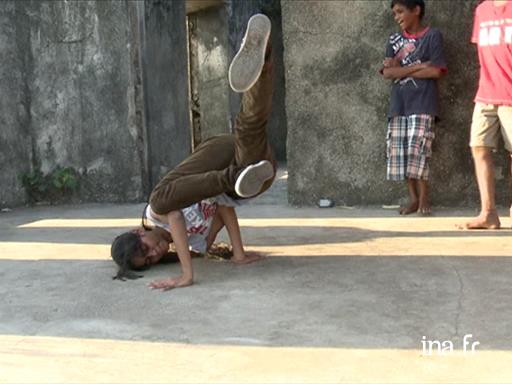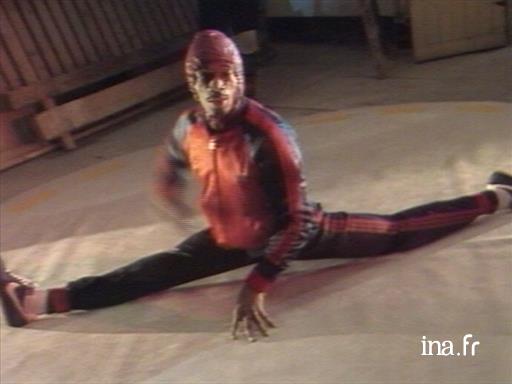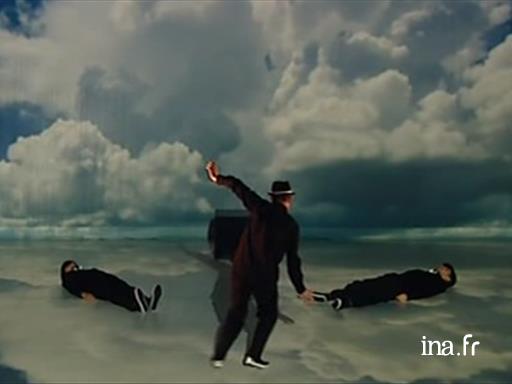
Hip hop, a migratory dance
Introduction
Hip hop is unique inasmuch as it is not an isolated discipline. It is associated, at least at the beginning when it was created in the Bronx in the 1970s, with other forms of artistic variants (graff and rap) of the movement to which it belongs. Hip hop is a way of being a citizen of the world or rather a citizen in the world, and some of the “moovs” are neither painters, dancers, nor even musicians. Another unique feature of this dance, born in the United States, especially in African-American and Puerto Rican ghettos, is its constant mobility. On the East Coast of the US, people mainly dance the breakdance, (floor dance) while on the West Coast, it is rather the smurf (standing dance) that has gained popularity. Barely ten years later, it was imported to Europe and then won over all the major capitals of the world, from Asia to Africa, and including Russia. It has also moved about on a social level: starting life out in New York ghettos, it is now taught in schools in the Marais in Paris, for example. Moreover, it is now an institution, and two of its pioneers are now directors of national choreographic centres in France. It owes this mobility to the TV and Sidney’s programmes and his famous dance lessons as well as to the Internet. Long considered a passing fad for the “unemployed youth of the outskirts", it was also able to “migrate” in terms of its content, moving away from American origins to enrich itself through contact with other contemporary, African, Creole, and Indian dances. Even if hip hop hasn’t stayed in the same place, it still has its place, including on an aesthetic level. Move away!
Made in the USA
It tells the story of a young black American, then a gang member of the Black Spades, who tried to put an end to the violence that was tearing his community apart. The man, who called himself Afrika Bambaataa in reference to the film Shaka Zulu, where a Zulu King defied the English colonists, took the side of the oppressed and changed his life, swapping his weapon against a record deck. He created a first group Organization, bringing together important figures of the hip hop movement, and defining the ethical and aesthetic values. In January 1975, his best friend Soulski died following a shoot-out where the police intervened in a dispute between the Black Spades and another gang. He left the Black Spades and founded the Zulu Nation. While gangsters were cutting up the districts to mark out their territories, he took it on himself to welcome all communities in his organization: "The Zulu nation is not a gang, he proclaims, *it is an organization of individuals looking for success (which it found), peace, knowledge, wisdom, understanding and the right behaviour in life." Without being a prophet or pastor, he knows how to bring people together, and doesn’t close the door to anyone. Many still follow him and his teachings.

New York, New York, the big Apple, the history of Hip-hop
Filmed in New York, this report (with its many special effects) looks at the Zulu Nation, founded in New York in the early 1970s, and the origin of hip hop culture. The journalist Bernard Zechri interviews Afrika Bambataa, Bronx disc jockey, and creator of the Zulu Nation, an organization that brings together artists who express themselves through break dance, rap and graffiti art.
The way is clear for inventing. The streets become dance floors. Sneakers cannot be worn without being accompanied by ghetto-blasters, radio-cassettes players, which are as huge as their volume is loud. In the Bronx, everyone performs breakdance, which is particularly physical and acrobatic, with its basic steps and figures that became the vocabulary of this coded dance, developed by B.Boys. Its international lexicon has remained the same despite variations of syntax or personal additions. Everyone knows how to do the drop, the spin, the windmill, the toprock, and the head spin...
On the West Coast, Boogaloo Sam created the popping, and formed his crew in the mid-70s, the Electric Boogaloo lockers. As with what usually happens when stories are passed on orally, there are numerous versions of the same story. Some say that this dance was connected with the smurf (standing dance) and to the funk style created in reference to the blue and white characters. Others say that it had nothing to do with the smurf originally but this was just a story "invented" by the French. Whatever the real story: with their chic white gloves, the smurfers sway, explode like popcorn and try to do the moon-walk as best they can, popularized by Michael Jackson (which owes much to Mister Freeze).
In France, from the street to the contemporary scene
After being popularized by Sidney’s programme H.I.P. - H.O.P. in 1984 on TF1, hip hop soon spread to the French suburbs. Quickly, and even if the figures and basic steps have not really changed, the dancers came up with a different style that was perhaps more theatrical, more formal in style, even for the street. They were also more open to other forms of dance like the dance group “Traction Avant” in Vénissieux, which incorporates contemporary styles and the butoh.

Furthermore, although it did not happen overnight, event organizers and critics eventually understood that this dance had its place on the contemporary scene. Christian Tamet, then Director of the Contemporary Theatre of Dance (TCD) became interested in these dancers. He fought to hold the first international meetings at la Villette in 1996 after having staged Sodebo, a show that brought together the best dancers from the Parisian suburbs at the time. Aktuel Force, Boogie Saï, Tony Maskot... At the Theatre de Suresnes Jean Vilar, Olivier Meyer wanted to bring together contemporary choreographers and therefore created Cité Danse Connexions. Guy Darmet from the Maison de la Danse in Lyon invited dance companies in the region. Jean-Paul Montanari from Montpellier Danse organized a mega meeting at the city’s Corum and then joined forces with the Boty (Battle of the year) to organize master classes. Moov'n Aktion organized the Tanz Hip Hop festival in Seine-Saint-Denis... And many others decided to go down the same path. Until the appointment of two choreographers to head the national choreographic Centres: Kader Attou in 2008 in La Rochelle, Mourad Merzouki in Créteil in 2009 who also created the Pôle Pick in Lyon-Bron.

Fluxus game, interview with Farid Berki
"Fluxus Game": Hip hop, dance, and juggling, choreography by Farid Berki. The choreographer is interviewed at the théâtre de Suresnes where his show is produced. He explains his approach, his penchant for crossing borders, being of mixed origin himself. He describes hip hop as a hybrid par excellence.
While hip hop in the United States was monopolizing TV and was being videoed for rappers’ music clips (starting with Michael Jackson and Madonna), in France, it was affirming its “exceptional” nature by winning over the national stage and festivals, and was being shown the same importance as the then dominant contemporary dance. The latter started to show ever more interest in this movement and included hip hopers in its dance companies, such as those run by José Montalvo and Dominique Hervieu, Josette Baïz, Doug Elkins and Karole Armitage. Hip hop left the cities. Hip hop schools opened: Juste Debout in Paris created by Bruce Ikandji, and Guy Weladji and Anthony Egéa’s school in Bordeaux. The technical level continued to improve, and Asian dancers (Korean & Japanese) started to appear in force in the battles, and started to set the bar very high. A real stimulation is the challenge, one of the fundamental principles of hip hop, where each dancer challenges the other to do better than him. Not just for the prize but to “win in your head” says Sidney.

Breakdance competition, hip-hop battle
This documentary lets us share a part of the daily life of two Hip-Hop dancers, including the first World Cup at Bercy and an international tournament in Miami, Florida. Images of training sessions and performances on stage alternate with interviews with both the protagonists of this new art. We follow two dancers, Bibiche and Neil, in their daily lives and during their training up until the final tournament where the best dancers compete in Miami.
Even though women initially found it difficult to get a foothold in this very male environment, they have not failed to bring their personal touch, whether it be the pioneers in the mid-1980s, Karima, Kiyoharu, Bintou Dembele and even Anne Nguyen who organizes dance evenings with a new dance for couples: the pop loop.
Hip hop, which is very rich in terms of its vocabulary, and colourful thanks to the multiple origins of its dancers, especially African, was incorporated into black American animal dances, such as the chicken, the kiss of the rabbit, tap dance, miming, "skating" by James Brown, and capoeira. It will still need to resist becoming overly “academic”, it may as an institution lose some of its richness. Despite being beautifully staged and executed, a number of today’s performances leave us feeling indifferent, they seem to be devoid of the initial energy and any particular meaning, or dramaturgy. This activist dance - with its social demand whereby everyone can find a place and can make a name for themselves in society - sometimes loses sight of its relevance and its political scope, to almost become a mere form of entertainment, as it has already become in TV studios. But the battles are “calls to order”, like the krump (praise of the powerful kingdom) born in Los Angeles after the 1992 race riots. The krump adopted a warrior-like attitude and has continued to develop in Korea.

The Krump, new dance based on hip-hop and African tribal dances
Presentation of a new dance, the krump, with its jerky moves and frantic pace, originating from the ghettos of Los Angeles. We meet the Diamontz group, composed of young girls who give us a demonstration. Two of their dancers mention the side of krump that is both energetic and liberating in this choreography. The sociologist Antoine Garnier places it in a social context.
Around the world, hip hop is still a sign of youth protest.



